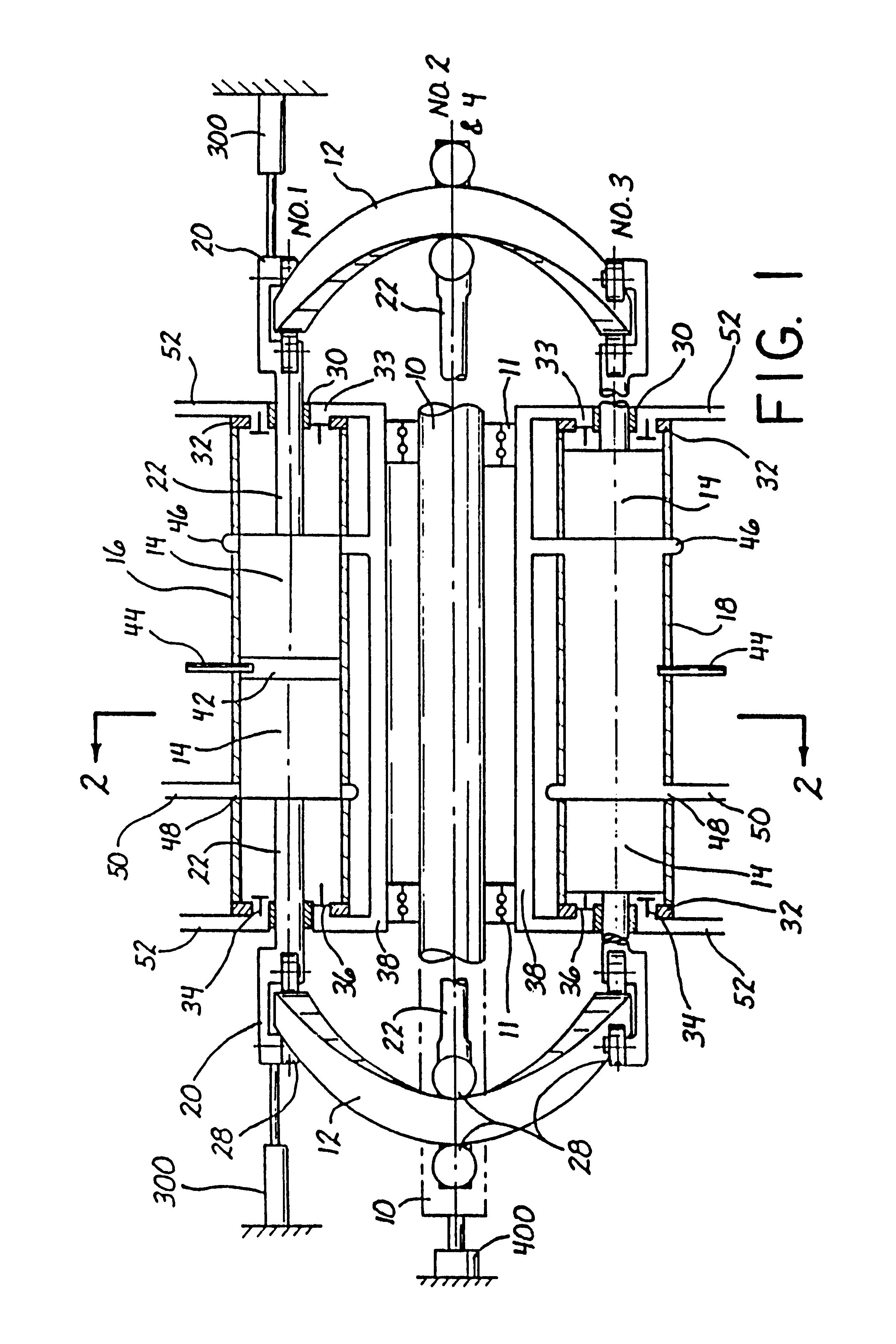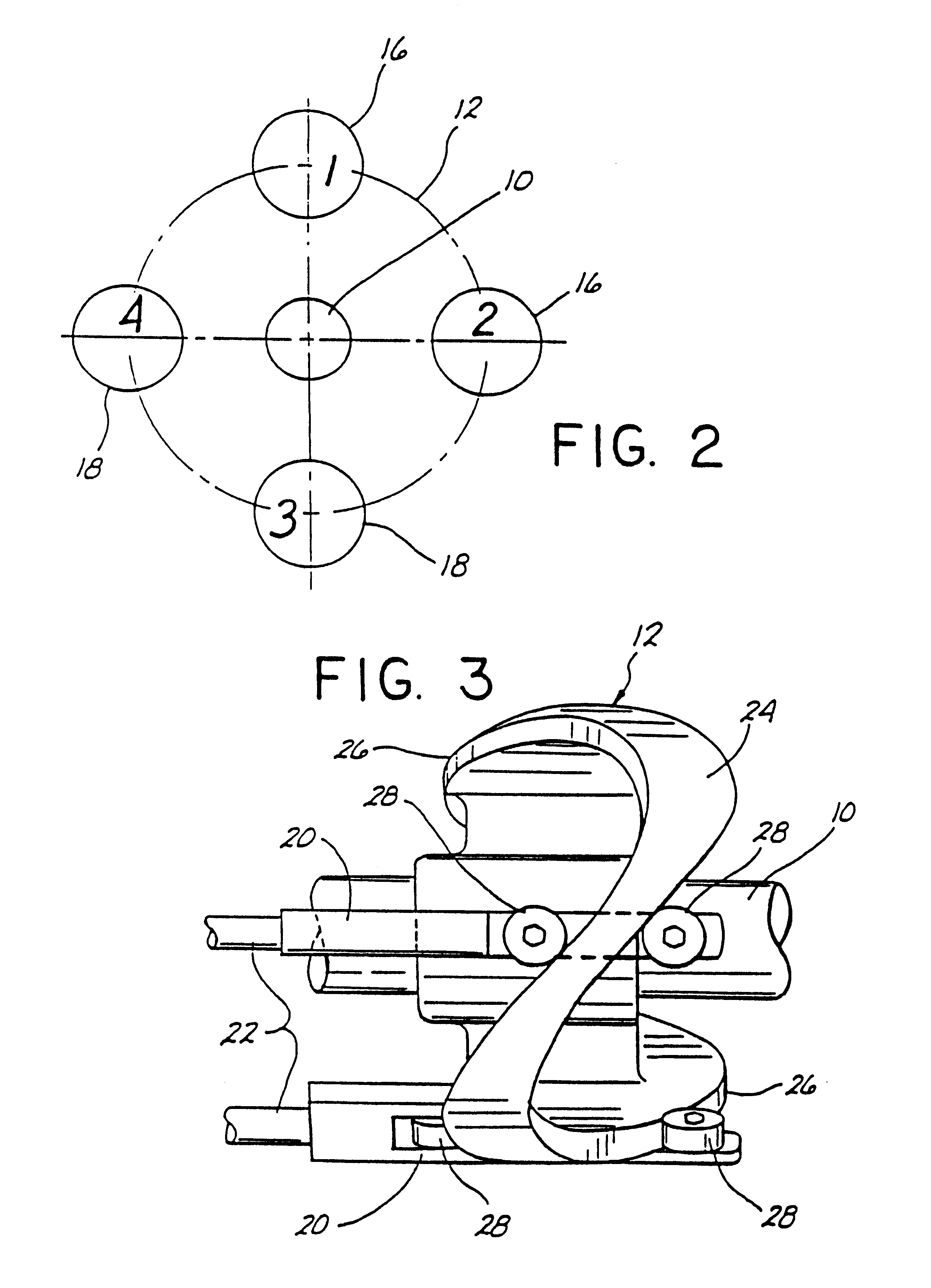However, due to these materials prior art engines require supplemental cooling and lubrication in order to function properly with adequate durability.
These cooling and lubrication requirements further require provisions for
fluid circulation and
heat rejection accessories that can be burdensome in many applications.
Aircraft applications of such engines are particularly sensitive to the installation of such accessories because of the weight and
aerodynamic drag associated with their proper usage.
In addition, the control of fluids in aircraft engines and their remote accessories such as radiators, oil coolers, pumps, oil sumps and the like is complicated because a fixed gravitational orientation can not be relied upon to disengage vapors and liquids and establish fluid levels.
A further
disadvantage of most prior art engine constructions for aircraft applications is their dependence on increased output shaft speed as a means of reducing weight per unit of
power output.
Such mechanical accessories have cooling and lubrication requirements of their own and can add significant weight, cost and complexity to the installation, particularly for small-engine and high-altitude applications.
Most prior art engines employ structural arrangements, assemblies and mechanisms that are highly dependent on the tensile properties of the customary
metallic materials which have limited temperature tolerance, expand significantly when heated and are prone to
galling under sliding and
rubbing contact.
They require sophisticated cooling and lubrication schemes to maintain their mechanical and
structural integrity and their weight and balance is
highly sensitive to increases in cylinder working pressures and rotational speeds.
Thus, prior art engines that operate on the
diesel cycle are somewhat heavier and larger than their spark ignition counterparts and they also present greater lubrication, cooling and balancing burdens.
This accounts, to a large extent, for the lack of acceptance, heretofore, of prior art type diesel engines for aircraft applications notwithstanding their potentially superior flight-worthiness, safety, fuel economy and fuel flexibility characteristics.
However, such friction controls require advanced
chemistry for liquid lubrication.
Prior art engines that utilize crankshafts provide no
mechanical advantage in the conversion of piston motion to shaft torque.
Furthermore, eccentricities in connecting rods and the like produce side loads in the reciprocating pistons which give rise to friction and vibration.
However, none of these characteristics has been obtained in the prior art with the use of thermally tolerant and self-lubricated materials in the principal parts.
None of the prior art engines suggests the use of non-metallic construction or arrangements, hence, the burdens of supplemental cooling and lubrication remains.
However, the Sterling / Michel engine has
swashplate followers which impart significant side loads.
Furthermore, the articulated piston /
crankshaft arrangement imparts significant side loads as well.
The Junkers engine also utilizes a separate
scavenging system, requiring appurtenances which add to the complexity and weight of the engine structure.
Thus, it too has side load problems.
Sterling / Michel, Junkers and Hill all used opposed pistons, but none foresaw the opportunity for constructing their engines in a manner that could utilize in any significant respect thermally tolerant and self-lubricated materials.
Further, all utilize reciprocating-to-rotary conversion mechanisms that impart side loads on their pistons and which cannot provide any
mechanical advantage in the production of torque other than by the familiar method of increasing the piston stroke and / or combustion pressure.
Finally, none of these prior art engines included integral aspiration and
scavenging means, thus necessitating external or add-on appurtenances such as additional scavenge pump cylinders or separate mechanically-driven blowers.
However, this engine structure is mechanically very complicated and does not lend itself to the use of thermally tolerant materials.
However, Herrmann did not anticipate or suggest the use of double-
harmonic cams in an
opposed piston engine having an axial cylinder arrangement.
Thus, even though Herrmann's double
harmonic cam increases the number of piston strokes per shaft revolution, it only obtains one
power stroke per revolution.
Such an attempt to utilize the Herrmann single
cam teachings in a two-stroke-cycle engine would be encumbered by the need for highly stressed cylinder heads and difficult valving and
porting locations which necessitate the use of cooled and lubricated metallic construction.
This technique is burdened with the complexity of supplying
hydraulic fluid in a controllable manner through rotating and reciprocating members into the most intensely heated and highly stressed region of the engine, namely the piston crown.
This method is mechanically and structurally complex and it also requires intense cooling of the springs in order to prevent
premature failure of the mechanism.
This technique utilizes a pair of eccentric rocker shafts that are synchronously rotatable within heavily loaded bearings which requires a precise and robust mechanism having critical lubrication problems.
In fact, all of the prior art mechanisms described above are vulnerable to intense heat and load
exposure.
Reconnaissance of the prior art of opposed piston engines has failed to produce an example of means for simultaneously and independently altering both piston clearance and piston phasing during engine operation.
Thus, Timoney's method could not be used to optimize port overlap as well as
compression ratio.
Whatever the various advantages offered by many of these prior art examples, none overcomes the structural, thermal, mechanical, dynamic and frictional limitations that have been a barrier, heretofore, to the construction of an engine that can operate free of vibration, supplemental cooling and lubrication.
Such flow enhancement costs little additional power because of the lower scavenge pressures developed at
low speed so that an excess of flow over what is needed for scavenging does not penalize engine performance.
Furthermore, low speeds usually occur with partial load which, for a diesel, calls for considerable excess air (
oxygen) over chemical
correctness.
At these conditions, low
fuel injection quantities are required which usually attain a lower injection quality.
Under these conditions, excessive port overlap can produce over-scavenging which results in excessive parasitic power and reduced part-load engine performance.
Higher cycle performance is accompanied by higher mechanical loadings which produce greater friction losses tending to offset thermodynamic performance gains.
Further, the higher compression pressures, charge densities and fuel quantities
crowds the combustion space, increases
heat losses, and impairs injection and combustion performance.
Thus, a certain decrease in the
compression ratio occurs with an increase in the piston phasing.
Higher charge air pressures normally increase engine parasitic pumping power in two-stroke operation because of increased
charge density during the compression stroke.
 Login to View More
Login to View More  Login to View More
Login to View More 


